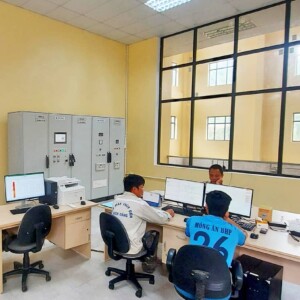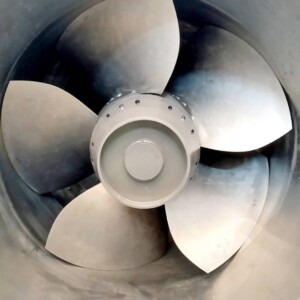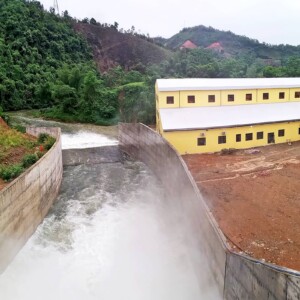Vietnamese hydropower plant Bach Dang is on the grid powered by Austrian turbine twins
Last May, hydropower plant Bach Dang in the Northern Vietnamese province of Cao Bang was for the first time able to generate clean energy. The facility was established by operator Thanglong Construction Group, who entrusted the implementation of the electromechanical equipment to the expertise of an Austrian hydropower specialist of international acclaim. GUGLER Water Turbines GmbH provided a comprehensive engineering package for this new construction, whose core elements are two horizontally aligned Kaplan turbines. Built for a flow rate of 13,85 m³/s and a 21 m net head, the machines provide a bottleneck capacity of 2.65 MW each. GUGLER’s equipment was complemented by two directly coupled synchronous generators by Siemens Gamesa and the entire electrical and secondary equipment.
In Vietnam, which has a population of around 90 million, hydropower is one of the principal sources of electrical energy. More than a third of the country’s generated power is produced with the renewable resource of water; the other two thirds are generated from coal, natural gas or nuclear energy. Of Vietnam’s annual hydropower potential of around 120,000 GWh, less than half is currently being utilised for energy production. This makes Vietnam one of the most attractive hydropower markets in South-east Asia.

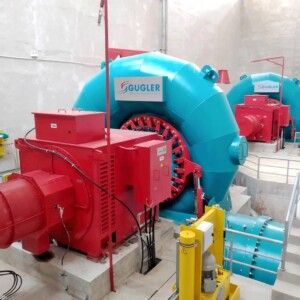
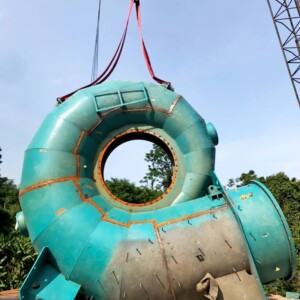
New power plant in Northern Vietnam
Criss-crossed with a network of rivers, the north-eastern Vietnamese province of Cao Bang provides ideal conditions for hydropower generation. In the mountainous region near the Chinese border, Bach Dang was one of the country’s newest hydropower plants to be connected to the grid for the first time. The facility was erected by Vietnamese operator Thanglong Construction Group, which is active in both the construction and energy sector. In accordance with the plant’s classic diversion design, the water dammed up by a massive concrete construction. In case of a flood, an alignment of three gates ensures the proper discharge of excess water. In the intake area on the orographically right side of the river, the water supply is regulated by two head gates. A crane construction running on a movable carriage controls the raising and lowering movements of all of the weir’s sluice gates. The power house right below the weir gate has its works water supplied through two parallel DN2300 penstock pipes, which are made from fibre reinforced plastic and measure about 70 m in length.
Manufacturing on two continents
Concerning the technical equipment for the power house, the operators relied on the internationally well-known competence of Austrian hydropower allrounder GUGLER Water Turbines GmbH. As Stefan Falkner, GUGLER’s project manager, explains, “When we were awarded the contract for the Bach Dang project in January 2019 we went straight into the machine designing and planning phase. The core elements of our delivery were two horizontally aligned Kaplan turbines, including the generators and the entire electromechanical equipment. What made this project special was that the customer wanted the draft tubes, the inlet pipes and the turbine spirals to be manufactured in Vietnam, based on design plans from GUGLER. The mechanical parts, such as the guide vane assembly, the runners, the runners chamber liners and the adjustment mechanism for the runner blades were provided by our Slovenian partner.” As Falkner admits, the design of the 7.5 m turbine spirals required considerable effort to calculate. To prevent the steel parts from warping out of shape under their own weight, the construction had to be specially reinforced. Due to their large size, each of the two spirals had to be delivered in four parts, which were then welded together on-site.
Corona wrecks the project plans
When the Corona pandemic hit in the Spring of 2020, it did not leave the Bach Dang hydropower project unaffected, as Falkner confirms: “Originally, we had scheduled on-site construction work to start in April 2020. In late 2019 we had done a workshop testing, where the customer’s representatives had inspected and approved the equipment that was manufactured in Slovenia. In early 2020, the components were shipped to be delivered to Vietnam. After that, however, the restrictions and entry limitations caused by the pandemic put a halt on the project for quite some time.” It was only in October 2020 that the installation of the turbines finally went ahead. Local specialists performed the installation work under the supervision of a GUGLER engineer, who had been forced to stay quarantined in a hotel for two weeks after arriving in Vietnam. Installing the guide vane assembly required the turbines to be rotated by 90 degrees at the installation site. With that accomplished, the machines were repositioned and hoisted into their installation position with an indoor crane. “That was a bit of a challenge, as the guide vane system is usually pre-assembled at the factory. But thanks to the excellent collaboration, we were able to complete initial installation work as scheduled, by Christmas 2020,” says Falkner.
High-performing turbine twins
A casual glance over the structurally identical machine units might lead one to believe they are Francis turbines. A closer look at the runner adjustment mechanism, however, reveals that they are horizontally aligned, double-regulated Kaplan turbines. The precise regulation of the guide vane and runner blade adjustment mechanism is taken care of by two hydraulic pressure units, which were also provided by GUGLER. Each of the turbines is optimised for a design flow rate of 13,85 m³/s and a net head of 21 m. As a result, the machines can achieve a bottleneck capacity of 2.65 MW each. Thanks to the low amount of sediment in the works water, there was no need to apply a protective coating to the five-bladed stainless steel runners, each of which measures 1,550 mm in diameter. Two synchronous generators by Spanish provider Siemens Gamesa are coupled directly to the runners to convert the kinetic energy into electrical current. “Our customer requested mechanical seals to be installed between the turbines and generators. These seals are relatively large components, and the Bach Dang plant was the first one where we installed them,” says Falkner. The air cooled generators were designed for a rated apparent power of 2,993 kVA and a voltage of 6,300 V. Two oil lubrication units combined with cooling circuits and underwater heat exchangers keep the oil of the maintenance-free slide bearing reliably cool.
GUGLER hard at work in Vietnam
The installation of the plant’s electrotechnical equipment was carried out primarily by local engineers. They were supported by a long-standing GUGLER partner from Croatia, who acted as a sub-contractor for the delivery of the electrical and secondary equipment. The SCADA system with intuitive user interface allows the facility’s energy production to be fully automated. A secured on-line connection enables the operators to monitor and remote control the plant’s equipment. Any malfunctions or alarms are forwarded automatically to operating staff. Moreover, each of the machine units is designed for autonomous operation, which allows energy production to continue even if a unit fails. The energy generated is transmitted from the generator terminals to the medium-voltage switchgear on the power house’s upper level. From there, the electricity is fed to two GUGLER transformers and on into the public grid. Hydropower plant Bach Dang was officially inaugurated after the completion of the final installation work around a year ago, in May 2021. “Despite the delays because of the Corona pandemic, we were able to complete the project successfully. First and foremost, this was thanks to the highly constructive collaboration and communication with the customer’s representatives. We are also grateful to all the other providers for a job well done,” says project manager Falkner. For the Austrian hydropower experts the South-east Asian region remains a highly attractive market. In Vietnam alone, two further power stations are about to be inaugurated, and three further projects are already at advanced stages.
